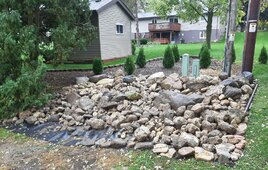Thanks for the idea. But. Heat pump water heater are great especially in southern climates. Since like all heat pumps they remove the heat from the air and put it into the tank. They in turn cool the air around them. Not really a great idea when up north. Especially when the only time I would be using it is in the middle of winter.
You do realize 1 Kwh of electricity equals 3,412 btu's?
If you are planning on using PV direct to heat water for heating a house, driveway or other large heat loss object, the amount of Kwh needed is quite high. Missouri Wind and Solar put out this chart showing how many watts needed to raise water temp X number of degrees per hour.
https://windandsolar.com/how-to-size-a-dc-water-heating-element/
I plan on using my heat pump water heater to supply domestic hot water in my house in the winter. Yes, it will draw some heat energy from the surrounding area if I use the heat pump. I can also use the 4500W heating element instead to heat water by simply changing the source on my phone from anywhere I have cell service. In winter, the heat pump water heater will be mainly a dump load that either will heat all the water or tempers it before the propane water heater.
I live in northern IA, about 20 miles south of MN border and west of WI about 80 miles. It gets cold here too.

And It would be running constantly. During any day that the sun is shining. AC in an insulated area you want to keep as hot as possible. Heat pumps are awesome there efficiency is great. But it declines when trying to pull heat out of -20° air that's why they aren't used too much up nort der hey.
My heat pump water heater is in my basement. It stays about 60°F there all winter even when it's -30°F here in Iowa there ey. I'm not concerned about the heat energy it will pull from the basement during winter, during extreme cold I heat with wood or the propane furnace.
They do make northern climate heat pumps that can somehow pull heat out of really cold air. But again at major loss of efficiency and durability. Due to having to run constantly, during the winter.
You are referring to outside units like air to air mini splits. I'm not putting my water heater outside, the heat loss would be quite large.

Thats why I installed my geothermal. Heat pump that only has to take heat out of 56° water. And for that matter it gets to put heat into 56° water. During the summer. Way less work. That's why geothermal heat pumps can last 30- 40 years. They aren't trying to pull heat out of -20° air and trying to put heat into 90° to 100° air.
A geothermal heat pump would be the best to heat my driveway. But again lack of space in my yard for loops. And cost. I got 3 estimates for geothermal for my house/shop. All 3 had different ideas for equipment. And all 3 came back estimate of just over $45,000. Like they all got together and said lets tell him $45,000. I installed it myself for a little over $22,000. With Warmboard infloor heat upstairs. And that includes paying $5,000 to have the loops installed. It took me a month to figure it all out and still working 65+ hrs driving a forklift to pay for it. If I knew what I was doing. I probably could have installed it in a day maybe 2. So the geothermal guys where making $23,000 + for a couple of days work.
You have geothermal which is what you should be using to heat the water as the electricity used with a COP of more than 4 (geothermal) would be more efficient than DC direct. Remember, one Kwh of electricity equals 3,412 btu's. A heat pump with a COP of 3 makes the 1 Kwh of electricity 10,236 btu's and a COP of 4 is 13,648 btu's.
Sorry I got off on a rant.
Anyway thanks everyone for the information. It's greatly appreciated.
If you want to drill wells, you need to be like Larry who I ran across one day on Youtube. Actually, you could simply use his method of extracting ground heat for your driveway clearing in winter, just pump closed loop water glycol from the ground which should be around 55°F and circulate it thru your driveway loops.
I would drill with a large hole and much faster using this method. Just pull the casing back up and run your loops down the hole like Larry. Four 40 foot deep wells would be 320 feet of loop.



